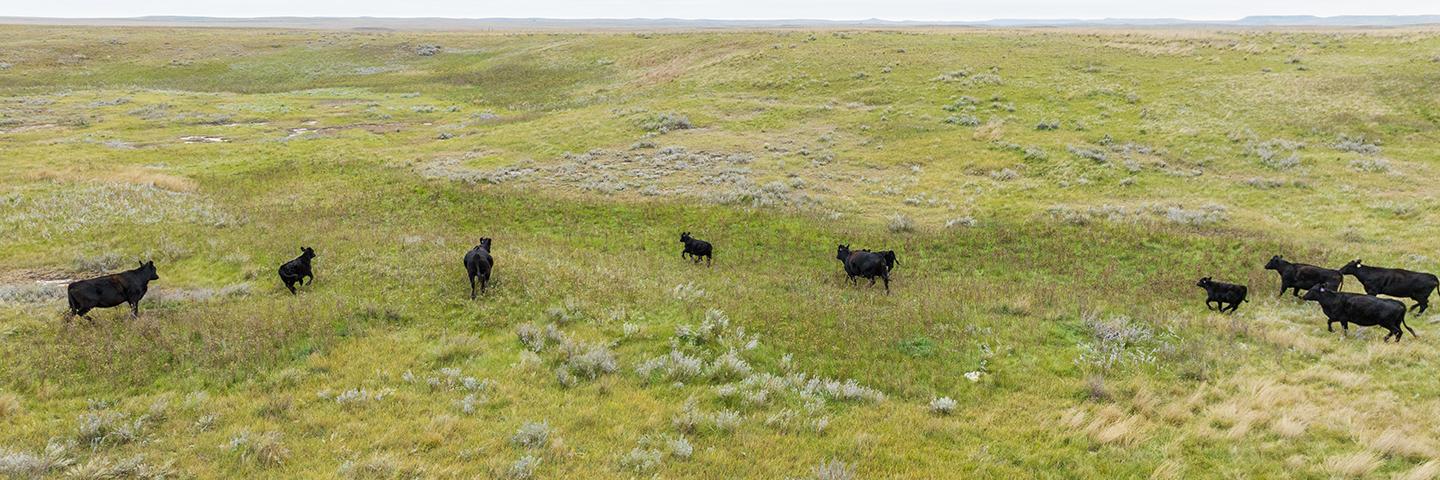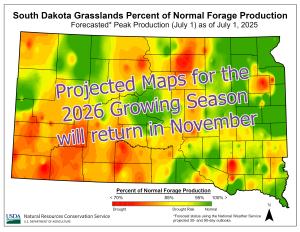Mid-May Forage Production Report and Outlook

Mid-May Grassland Productivity Maps
Huron, SD, May 19, 2025— Mid-May is here which means it is time to update the South Dakota (SD) Grassland Productivity Maps with conditions changing slightly since the last forage update on May 1.
Produced through the SD Natural Resources Conservation Service (NRCS) Drought Tool, these maps will be updated approximately every 15 days utilizing a two-year weighted average of precipitation data to determine a percent of normal production calculation incorporating historical clipping data from across the state. Forage maps relate to grassland forage production and not cropland as the maps will not predict forage quality. These reports will subside starting July 1.

“The ‘current’ map compares and averages precipitation from the last two years — this map shows that we have received below average precipitation throughout much of SD. An open winter, dry fall, and fairly dry spring have not set up our forages for a high-producing year. The ‘forecasted’ map shows what peak forage production will look like if the remaining time between now and July 1 has average precipitation,” says State Rangeland Specialist, Emily Rohrer.
Although the National Weather Service’s 30 and 90-day projected outlooks show a greater chance for below normal precipitation, the good news is we did get some nice rains the past few days that will alleviate some of the low moisture woes we have been feeling and give our planted crops and forages a much-needed drink.

As you begin to turn-out livestock onto pastures, make sure that you align your forage demand with forage supply — try not to graze forages too close to the ground, however, if unavoidable, allow closely grazed pastures a long rest period during the growing season so plant roots and shoots can recover from the grazing event. Long rest periods during a dry spell should be 60 days or longer, depending on plant recovery. If possible, try not to graze pastures twice during the same season if they have not adequately recovered — this will help reduce the likelihood of unwanted plants encroaching in your pastures and will keep the plants that are desired healthy for years to come.
There are several upcoming opportunities to learn more about the strategies you can take to improve grazing quality on your operation – even during a dry period. Consider attending the Young Adult Ranching for Profit Workshop to be held in Faith, SD, June 2-5 (ages 18-30), SD Rangeland and Soils Days in Belle Fourche, SD, June 10-11 (ages 8-18), or one of the three SD Grassland Coalition’s Grazing Schools, the first event is in Wall, SD, June 17-19.
For additional recommendations, visit with a local NRCS conservationist, South Dakota State University extension specialist, or consider asking a mentor through the SD Soil Health Coalition’s mentoring app: Growing Connections or seek out the SD Grassland Coalition’s mentoring network.
The following resources are also available:
SD NRCS Range and Drought page: bit.ly/Range_Pasture
South Dakota Grassland Coalition Drought Planning website: sddroughtplan.org/
National Drought Mitigation Center: drought.unl.edu/ranchplan/Monitor.aspx
National Integrated Drought Information System: drought.gov/
U.S. Drought Monitor: droughtmonitor.unl.edu
South Dakota State University Extension Drought Resources: extension.sdstate.edu/drought
SD Growing Resilience Web page: www.growingresiliencesd.com
SD Grazing Exchange: www.sdgrazingexchange.com/
###

